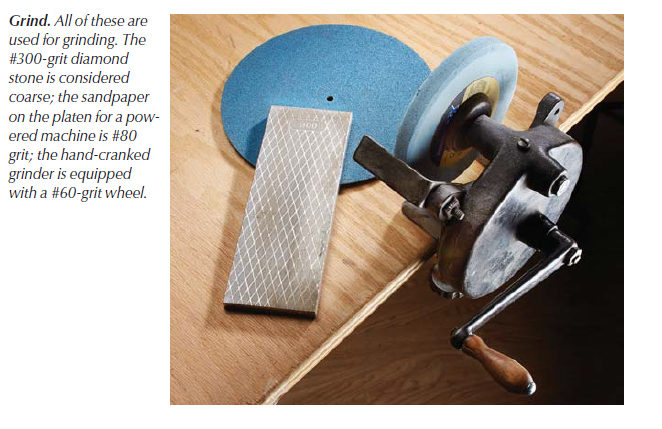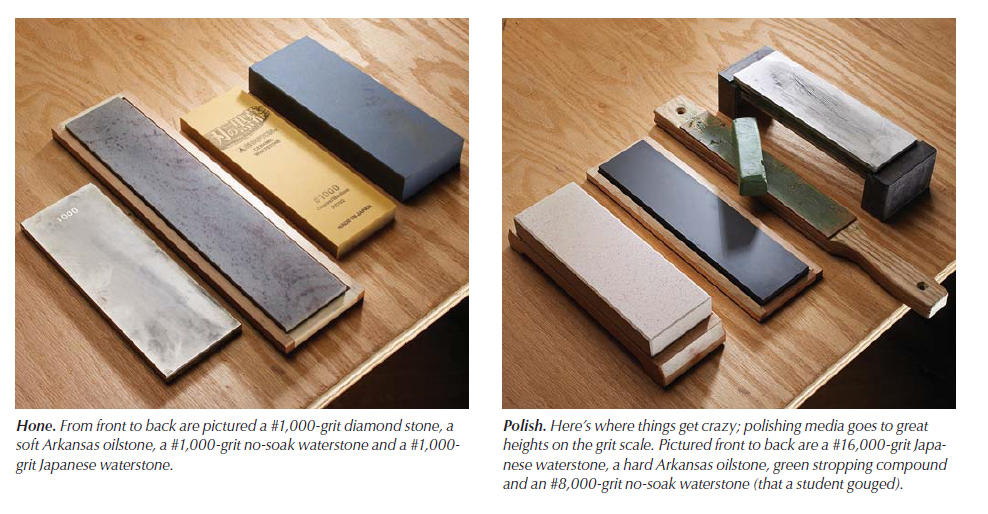We may receive a commission when you use our affiliate links. However, this does not impact our recommendations.
Among the fundamental skills necessary for good woodworking, I’d put knowing how to sharpen your edge tools at the top of the list. Even if you consider yourself a power-tool woodworker, I’ll bet you have at least a chisel (or two) and a block plane in your kit that need sharpening from time to time.
There are many different ways to sharpen: waterstones, sandpaper, mechanical solutions, oilstones and more. Now I’m not about to stick my head in the lion’s jaw and recommend one system over another (and I’m certainly not going to tell you whether or not to use a jig).
No matter what media you use to sharpen, there are but three operations: grind, hone, polish. (And most of the time, you can skip the first one.)
Grind
Grinding is done with a rough grit: #40 or #80 grit on a power grinder, #40-grit sandpaper on glass, a coarse diamond stone, a hand-cranked grinder, an #80-grit waterstone. But you don’t grind every time you sharpen – do this only when you need to fix a damaged edge, shrink a secondary bevel that’s become too large, or change the shape of an edge.
Hone
Unless you let your tools go for too long between sharpenings – or you damage a blade – honing is where you’ll start sharpening nine times out of 10. Honing simply erases the existing dull edge and cuts a new one. Just run the blade on the rock until you turn a burr on the backside. That burr means you’ve created a zero-radius intersection of two points – also known as a sharp edge. In fact, that’s as sharp as you can get it.
Polish
Everything above honing – from a #4,000-grit waterstone to the miniscule particles in a honing compound to a workaday hard or translucent Arkansas stone to a #30,000-grit Japanese waterstone – is polishing.
No matter how high you go, all you’re doing is progressing up the scale to a higher polish on the blade – that is, with each higher subsequent grit, you’re erasing the scratches from the previous grit (and creating new, tinier scratches).
This doesn’t make the blade any sharper – you (ideally) achieved a zero radius while honing. But polishing does make your newly sharp tool a lot more durable. Smaller and shallower scratches mean a less friable edge.
–Megan Fitzpatrick
p.s. – Subscribe to Popular Woodworking Magazine for full-length articles on crucial topics like this!
Here are some supplies and tools we find essential in our everyday work around the shop. We may receive a commission from sales referred by our links; however, we have carefully selected these products for their usefulness and quality.












I agree, excellent post Megan. Two is not enough! I was fascinated to learn about the detrimental effect of a “sawtooth” edge on the durability of even a well-honed chisel or plane iron. After honing, there remains tiny “sawteeth” along the edge that are cantilevered, or unsupported, hanging out there so to speak. When planing, I was quick to notice my freshly honed plane felt dull after only a few passes. Those tiny sawteeth break off quickly leaving a dull edge. That is when I decided to get serious about my sharpening regiment and learn more, work less. I experimented with a variety of polishing mediums and substrates, which in itself was half the fun. I now use either CrO2 (green) compound, or diamond spray or paste, on leather, hard maple, balsa wood, or even MDF scraps. I also use an extremely fine natural Japanese waterstone I had the opportunity to acquire. Whatever is close by and convenient to use. They all work well for my needs, although my experience with diamond is that a very slight toothyness is still perceptible. A Britisher once told me apple pie without the cheese is like a kiss without the squeeze. I’m pretty sure she really meant don’t leave out the polish, and was confused due to hunger, or something…
Excellent article Megan. All this talk about one method over another is a bit over the top. Use what you like and don’t worry about it. The important part is just what you talked about. It’s the results that count. How you get there and how far you wish to go with it is up to the user. I’m not sure why so many hang onto the words of the experts like it is an absolute and only way to do things. Maybe because some of the experts think their way is absolute and the only way?